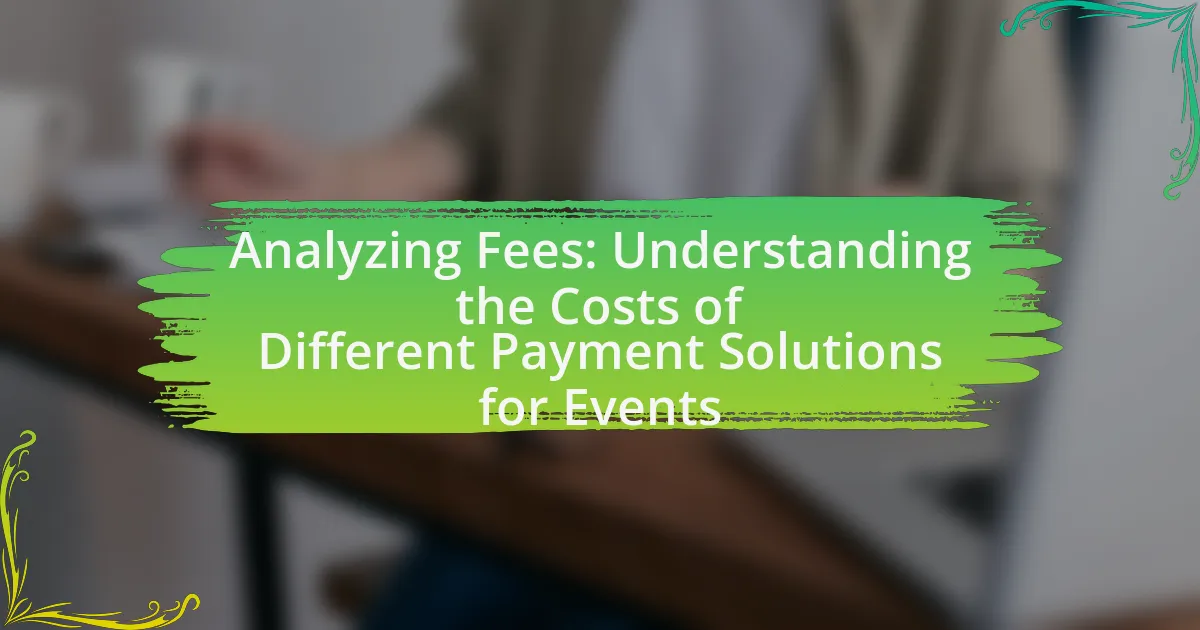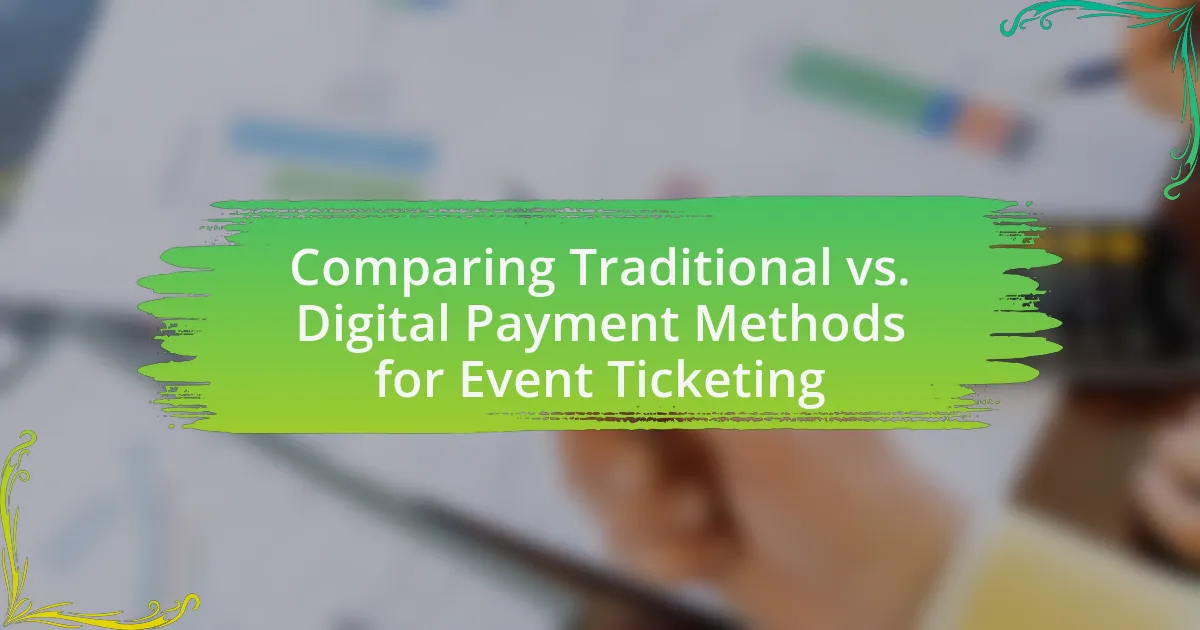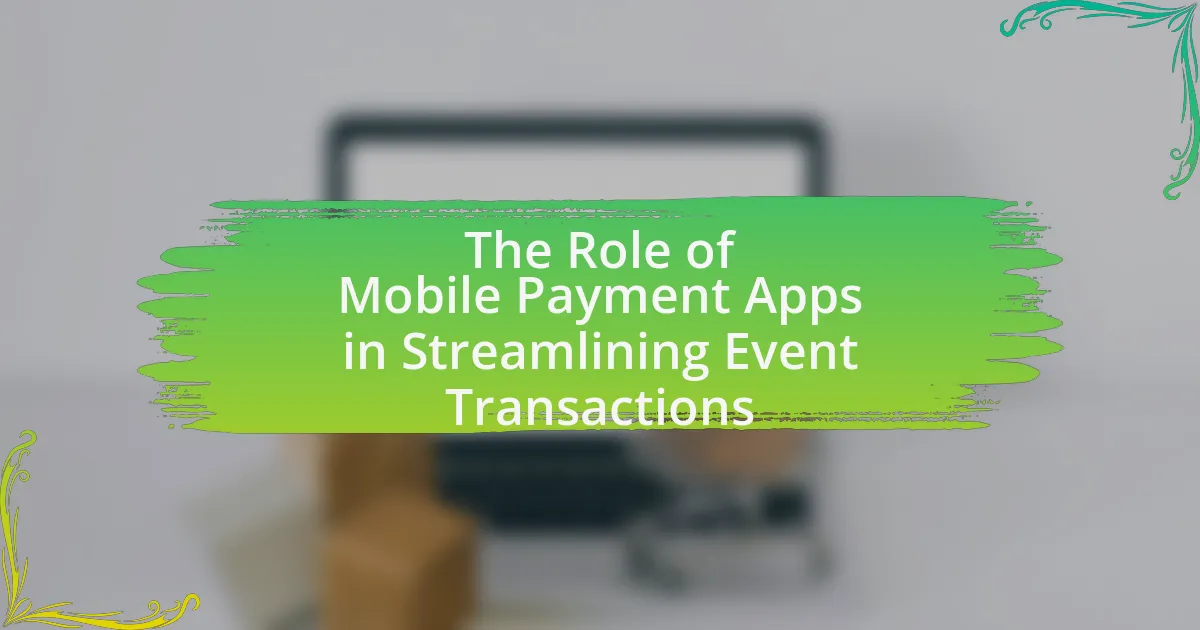Contactless payments in event management represent a significant advancement in transaction technology, allowing attendees to make purchases without physical contact through methods such as NFC and RFID. This article explores the functionality, advantages, and evolving adoption of contactless payment systems in events, highlighting their impact on attendee experience and operational efficiency. It also addresses the challenges faced by organizers, including technological integration and security concerns, while examining future trends driven by consumer preferences and technological innovations. The discussion emphasizes the importance of contactless payments in enhancing convenience, safety, and overall satisfaction at events.
What are Contactless Payments in Event Management?
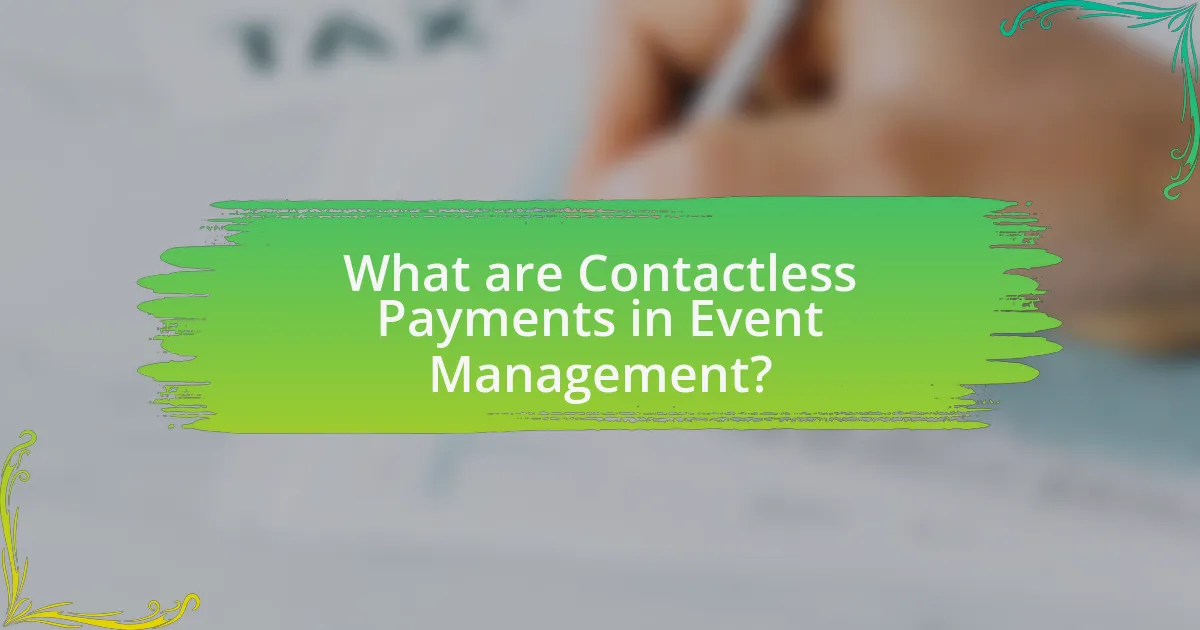
Contactless payments in event management refer to transactions that allow attendees to pay for goods and services without physical contact, typically using technologies like NFC (Near Field Communication) or RFID (Radio Frequency Identification). This method enhances the attendee experience by providing a quick, efficient, and hygienic way to complete purchases, which is particularly valuable in crowded environments such as festivals or conferences. According to a report by Statista, the global contactless payment market is projected to reach $6 trillion by 2024, indicating a significant shift towards this payment method in various sectors, including event management.
How do contactless payments function in the context of events?
Contactless payments function in the context of events by enabling attendees to make transactions quickly and securely using NFC (Near Field Communication) technology. This technology allows users to pay by simply tapping their contactless-enabled cards or mobile devices on a reader, streamlining the payment process and reducing wait times at entry points and concession stands. According to a study by Mastercard, 82% of consumers prefer contactless payments for their speed and convenience, which is particularly beneficial in high-traffic environments like events.
What technologies enable contactless payments at events?
Technologies that enable contactless payments at events include Near Field Communication (NFC), QR codes, and mobile wallets. NFC allows devices to communicate wirelessly when in close proximity, facilitating quick transactions through smartphones or contactless cards. QR codes enable users to scan a code with their mobile device to complete a payment, providing a simple and efficient method for event attendees. Mobile wallets, such as Apple Pay and Google Pay, store payment information securely and allow users to make transactions using their smartphones, enhancing convenience and speed at events. These technologies collectively streamline the payment process, reduce wait times, and improve the overall attendee experience.
How do users interact with contactless payment systems during events?
Users interact with contactless payment systems during events primarily through tapping their payment-enabled devices, such as smartphones or contactless cards, on designated terminals. This interaction is facilitated by Near Field Communication (NFC) technology, which allows for quick and secure transactions without the need for physical contact. According to a study by Mastercard, 82% of consumers reported a preference for contactless payments due to their speed and convenience, especially in crowded event settings. This preference enhances user experience by reducing wait times and streamlining the purchasing process, making contactless payments increasingly popular in event management.
What advantages do contactless payments provide for event organizers?
Contactless payments offer event organizers increased efficiency and enhanced customer experience. By enabling quick transactions, organizers can reduce wait times at entry points and concession stands, leading to higher attendee satisfaction. According to a study by Mastercard, events that implemented contactless payment systems saw a 30% increase in transaction speed, which directly correlates with improved attendee flow and reduced congestion. Additionally, contactless payments minimize cash handling, lowering the risk of theft and errors, while also streamlining financial reconciliation processes. This combination of speed, security, and convenience makes contactless payments a strategic advantage for event organizers.
How do contactless payments enhance the attendee experience?
Contactless payments enhance the attendee experience by providing a faster and more convenient transaction method. This technology reduces wait times at entry points and concession stands, allowing attendees to spend more time enjoying the event rather than standing in lines. According to a study by Mastercard, events that implemented contactless payment systems saw a 30% increase in transaction speed, which significantly improved overall attendee satisfaction. Additionally, contactless payments minimize physical contact, aligning with health and safety preferences, especially in crowded environments. This combination of efficiency and safety makes contactless payments a valuable enhancement to the attendee experience.
What cost savings can organizers expect from implementing contactless payments?
Organizers can expect significant cost savings from implementing contactless payments, primarily through reduced transaction fees and lower cash handling costs. By utilizing contactless payment systems, event organizers can decrease the expenses associated with cash management, such as security for cash transport, cash counting, and the risk of theft. According to a study by the National Retail Federation, businesses that adopted contactless payments reported a reduction in transaction costs by up to 1.5% per transaction compared to traditional payment methods. Additionally, contactless payments can streamline the checkout process, leading to shorter lines and improved customer satisfaction, which can enhance overall revenue and reduce operational costs.
How is the adoption of Contactless Payments evolving in Event Management?
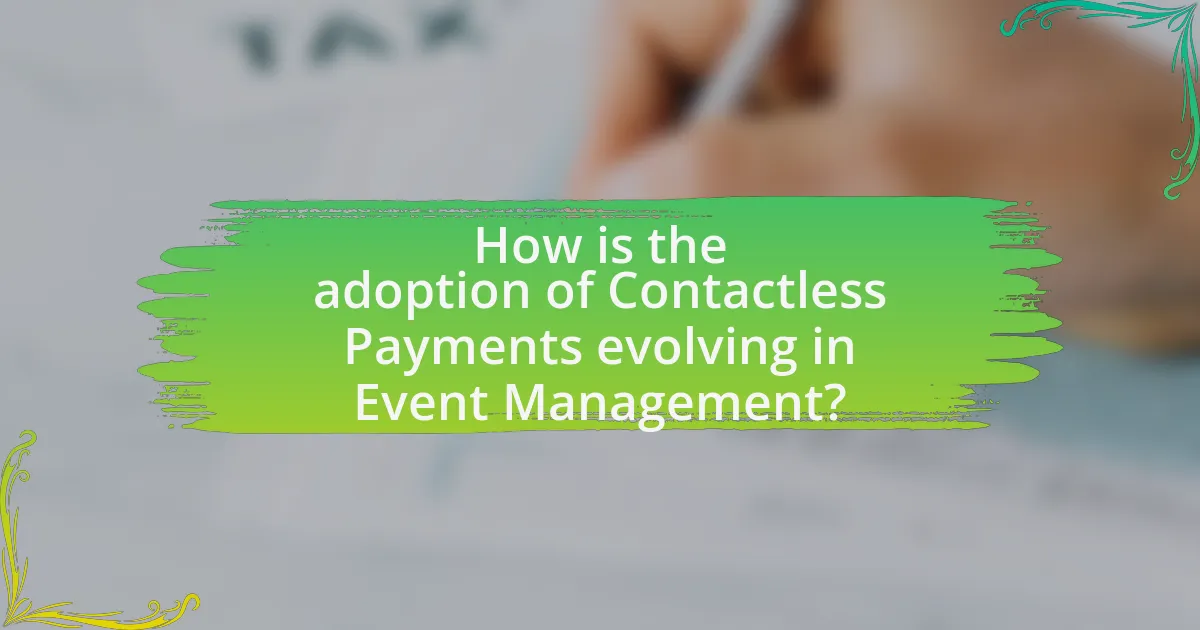
The adoption of contactless payments in event management is rapidly increasing due to heightened consumer demand for convenience and safety. Events are increasingly integrating contactless payment systems to streamline transactions, reduce wait times, and enhance the overall attendee experience. According to a report by Statista, the global contactless payment market is projected to reach $6 trillion by 2024, indicating a significant shift in payment preferences. Additionally, the COVID-19 pandemic accelerated this trend, as many event organizers sought to minimize physical contact and promote hygiene. As a result, major events now commonly utilize mobile wallets, RFID technology, and NFC-enabled devices to facilitate seamless transactions, reflecting a broader industry shift towards digital payment solutions.
What trends are driving the growth of contactless payments in events?
The growth of contactless payments in events is primarily driven by the increasing demand for convenience and speed among consumers. As attendees seek seamless experiences, event organizers are adopting contactless payment solutions to reduce wait times and enhance customer satisfaction. Additionally, the COVID-19 pandemic has accelerated the shift towards contactless transactions due to heightened health and safety concerns, with a report from Mastercard indicating that 79% of consumers prefer contactless payments for hygiene reasons. Furthermore, advancements in mobile technology and the proliferation of digital wallets have made contactless payments more accessible, leading to wider adoption in various event settings.
How has the COVID-19 pandemic influenced the shift towards contactless payments?
The COVID-19 pandemic has significantly accelerated the shift towards contactless payments as consumers and businesses sought safer transaction methods to minimize physical contact. This shift is evidenced by a surge in contactless payment adoption; for instance, a report from Mastercard indicated that contactless transactions increased by 40% globally during the pandemic. Additionally, many retailers and service providers implemented contactless payment options to comply with health guidelines, further driving consumer preference for these methods. As a result, the pandemic has fundamentally changed payment behaviors, making contactless payments a standard expectation in various sectors, including event management.
What role do consumer preferences play in the adoption of contactless payments?
Consumer preferences significantly influence the adoption of contactless payments by driving demand for convenience, speed, and security in transactions. Research indicates that 82% of consumers prefer contactless payments due to their quick processing times and reduced physical contact, which became particularly relevant during the COVID-19 pandemic. Additionally, a survey by Mastercard found that 74% of consumers are more likely to use contactless payments if they perceive them as safer than traditional methods. This shift in consumer behavior highlights the importance of aligning payment solutions with user expectations to enhance adoption rates in various sectors, including event management.
What challenges do event organizers face when implementing contactless payments?
Event organizers face several challenges when implementing contactless payments, including technological integration, user adoption, and security concerns. Technological integration can be complex, as organizers must ensure that their existing systems are compatible with new payment technologies, which may require significant investment and training. User adoption is another challenge, as some attendees may be unfamiliar with contactless payment methods or may not have the necessary devices, leading to potential delays and frustration. Security concerns also arise, as organizers must protect sensitive financial information from breaches and fraud, necessitating robust cybersecurity measures. These challenges highlight the need for careful planning and execution when transitioning to contactless payment systems in event management.
How can security concerns be addressed in contactless payment systems?
Security concerns in contactless payment systems can be addressed through the implementation of encryption and tokenization technologies. Encryption protects sensitive data by converting it into a secure format that can only be read by authorized parties, while tokenization replaces sensitive information with unique identifiers or tokens that have no exploitable value. According to a report by the Payment Card Industry Security Standards Council, these methods significantly reduce the risk of data breaches and fraud, as they ensure that actual card details are not transmitted during transactions. Additionally, incorporating multi-factor authentication and real-time transaction monitoring can further enhance security by verifying user identity and detecting suspicious activities promptly.
What technical issues might arise during the integration of contactless payment solutions?
Technical issues that might arise during the integration of contactless payment solutions include compatibility problems with existing systems, security vulnerabilities, and connectivity issues. Compatibility problems can occur when new contactless payment systems do not align with legacy hardware or software, leading to operational disruptions. Security vulnerabilities may arise due to inadequate encryption or authentication measures, exposing sensitive customer data to potential breaches. Connectivity issues can stem from unreliable internet connections or insufficient infrastructure, which can hinder transaction processing and user experience. These challenges highlight the importance of thorough testing and robust system design in the successful implementation of contactless payment solutions.
What is the future outlook for Contactless Payments in Event Management?
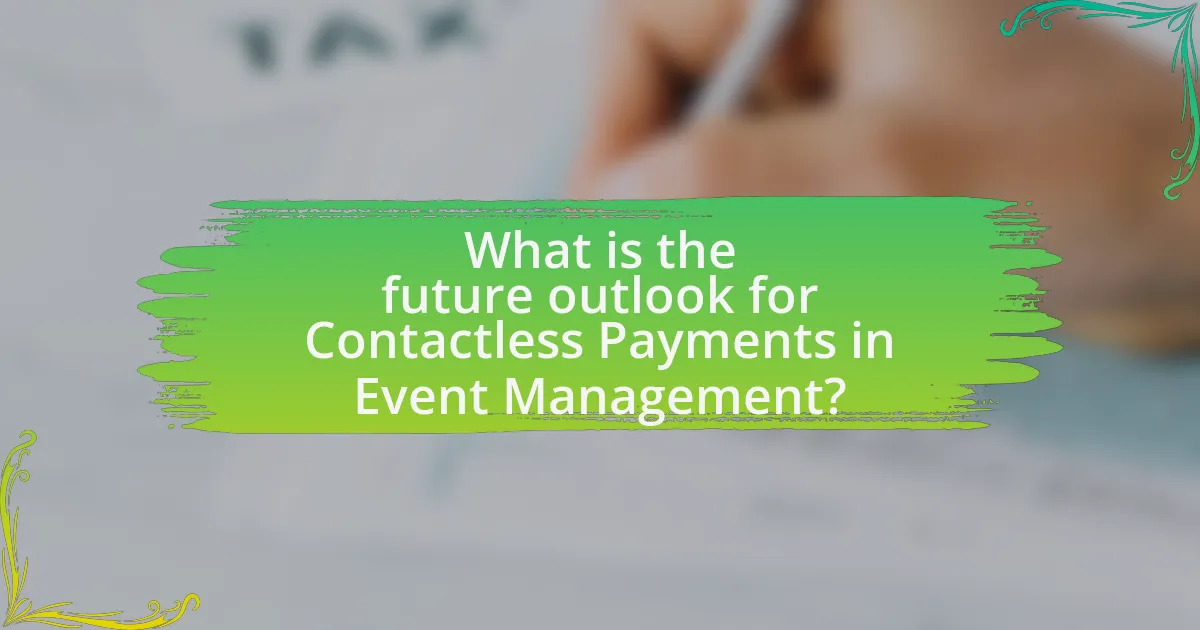
The future outlook for contactless payments in event management is highly promising, driven by increasing consumer demand for convenience and safety. As events continue to prioritize health and hygiene, the adoption of contactless payment methods is expected to rise significantly. According to a report by Statista, the global contactless payment market is projected to reach $6 trillion by 2024, indicating a robust growth trajectory. This trend is further supported by advancements in mobile payment technologies and the widespread use of smartphones, which facilitate seamless transactions at events. Additionally, event organizers are recognizing the operational efficiencies and enhanced customer experiences that contactless payments provide, leading to broader implementation across various types of events.
How will technological advancements shape the future of contactless payments at events?
Technological advancements will significantly enhance the efficiency, security, and user experience of contactless payments at events. Innovations such as near-field communication (NFC), mobile wallets, and biometric authentication will streamline transactions, allowing attendees to make purchases quickly and securely without physical contact. For instance, the global mobile payment market is projected to reach $12.06 trillion by 2027, indicating a strong shift towards digital payment solutions. Additionally, advancements in blockchain technology will improve transaction security and transparency, reducing fraud risks associated with event payments. These developments will not only facilitate faster transactions but also provide event organizers with valuable data analytics to optimize their services and enhance attendee engagement.
What innovations are expected to emerge in contactless payment technology?
Innovations expected to emerge in contactless payment technology include enhanced biometric authentication, integration of blockchain for secure transactions, and the use of artificial intelligence for fraud detection. Enhanced biometric authentication, such as fingerprint and facial recognition, will provide a more secure and user-friendly payment experience. The integration of blockchain technology is anticipated to improve transaction security and transparency, reducing the risk of fraud. Additionally, artificial intelligence will enable real-time monitoring of transactions, identifying suspicious activities and enhancing overall security. These advancements are driven by the increasing demand for secure, efficient, and seamless payment solutions in various sectors, including event management.
How might the integration of AI and machine learning impact contactless payments?
The integration of AI and machine learning will enhance the security, efficiency, and user experience of contactless payments. AI algorithms can analyze transaction patterns in real-time to detect fraudulent activities, significantly reducing the risk of unauthorized transactions. For instance, a study by the Federal Reserve found that machine learning models can improve fraud detection rates by up to 50% compared to traditional methods. Additionally, AI can streamline the payment process by optimizing transaction speeds and reducing wait times, which is crucial in high-traffic environments like events. This combination of enhanced security and improved efficiency positions AI and machine learning as transformative forces in the future of contactless payments in event management.
What best practices should event organizers follow when adopting contactless payments?
Event organizers should prioritize security, user experience, and technology integration when adopting contactless payments. Ensuring that payment systems are secure protects sensitive customer data, which is crucial given that 43% of data breaches target small businesses. Streamlining the user experience by providing clear instructions and minimizing transaction times enhances customer satisfaction, as studies show that 70% of consumers prefer faster payment options. Additionally, integrating contactless payment systems with existing event management software allows for seamless operations and better data analytics, which can improve future events.
How can organizers ensure a seamless experience for attendees using contactless payments?
Organizers can ensure a seamless experience for attendees using contactless payments by implementing reliable and user-friendly payment systems. These systems should support various contactless payment methods, such as mobile wallets and NFC-enabled cards, to accommodate diverse attendee preferences. Additionally, providing clear signage and instructions at payment points can help attendees navigate the process smoothly.
Research indicates that events utilizing contactless payment systems can reduce transaction times by up to 50%, enhancing overall attendee satisfaction. Furthermore, integrating real-time transaction monitoring can help organizers quickly address any issues that arise, ensuring a continuous flow of service.
What strategies can be employed to educate attendees about contactless payment options?
To educate attendees about contactless payment options, event organizers can implement interactive workshops and demonstrations. These hands-on sessions allow attendees to experience the technology firsthand, enhancing understanding and comfort with the payment method. Additionally, providing clear informational materials, such as brochures or digital guides, can reinforce the benefits and usage of contactless payments. Research indicates that 70% of consumers feel more confident using technology when they receive proper training or guidance, highlighting the importance of these educational strategies.




